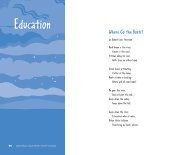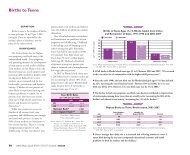2010 Rhode Island Kids Count Factbook
2010 Rhode Island Kids Count Factbook
2010 Rhode Island Kids Count Factbook
You also want an ePaper? Increase the reach of your titles
YUMPU automatically turns print PDFs into web optimized ePapers that Google loves.
Methodology<br />
children under age six must be screened<br />
annually for lead. In October 2007,<br />
the <strong>Rhode</strong> <strong>Island</strong> Childhood Lead<br />
Poisoning Prevention Program made its<br />
screening guidelines consistent with the<br />
American Academy of Pediatrics, which<br />
recommends a blood lead screening test<br />
for every child at one and two years of<br />
age. The Guidelines indicate that if<br />
either of the blood lead tests done<br />
at one and two years of age is > 10<br />
mcg/dL, annual screening should<br />
continue until the age of six. If both of<br />
the blood lead tests are < 10 mcg/dL,<br />
the pediatrician can use the Risk<br />
Assessment Questionnaire instead of<br />
a blood lead test until the age of six,<br />
which means that not all children<br />
receive an annual blood test after age two.<br />
Methodology for Youth Violence<br />
All law enforcement agencies in<br />
<strong>Rhode</strong> <strong>Island</strong> are required to maintain a<br />
record of the nature of detentions and<br />
characteristics of juveniles they arrest.<br />
They submit this information to the<br />
<strong>Rhode</strong> <strong>Island</strong> Public Safety Grant<br />
Administration Office on a monthly<br />
basis, and the information is aggregated<br />
into a summary report submitted<br />
annually to the federal Office of Juvenile<br />
Justice and Delinquency Prevention.<br />
More information can be found at<br />
www.rijustice.ri.gov<br />
Assault offenses in this indicator<br />
include: simple assault, robbery, assault,<br />
felony assault, assault with a dangerous<br />
weapon, domestic assault, assault on a<br />
police officer, threats, assault on a school<br />
teacher, strong-arm robbery, kidnapping,<br />
attempted murder, extortion, fighting,<br />
intimidating witness, stalking, attempted<br />
robbery, cyber-stalking, carjacking,<br />
harassment, and murder.<br />
Weapons offenses in this indicator<br />
include: possession of an unspecified<br />
weapon, possession of a knife, possession<br />
of a firearm, possession of a weapon at<br />
school, possession of a bb gun,<br />
discharging a firearm, possession of<br />
ammunition, possession of a dangerous<br />
weapon, carrying a concealed weapon,<br />
and discharging a bb gun.<br />
State-Operated and<br />
Charter Schools<br />
The state-operated schools and<br />
charter schools included in each table are<br />
listed in the Source/Methodology Section<br />
next to the table. Charter schools include<br />
only independently-run charter schools<br />
and not those affiliated with a district.<br />
Textron/Chamber of Commerce<br />
Academy, Times 2 Academy and the New<br />
England Laborers’/Cranston Public<br />
Schools Construction Career Academy<br />
are all district-affiliated charter schools,<br />
and consequently their data are reported<br />
within district categories instead of the<br />
charter school category.<br />
The Urban Collaborative Accelerated<br />
Program (UCAP) is listed separately<br />
when data are available.<br />
Charter schools, state-operated schools<br />
and UCAP are not included in core city<br />
and remainder of state calculations.<br />
New England Common<br />
Assessment Program (NECAP)<br />
In October 2005, <strong>Rhode</strong> <strong>Island</strong><br />
began using a new statewide assessment<br />
system for elementary and middle<br />
school students, and <strong>Rhode</strong> <strong>Island</strong><br />
implemented a new high school<br />
assessment beginning in October 2007.<br />
The tests were developed and<br />
administered in collaboration with<br />
New Hampshire, Vermont and Maine<br />
through the New England Common<br />
Assessment Program (NECAP), the first<br />
multi-state testing collaboration in the<br />
nation. The NECAP tests students in<br />
reading, writing and mathematics, and<br />
all test questions are directly related to<br />
specific state educational standards. Test<br />
results are available for the state, district<br />
and school levels on the <strong>Rhode</strong> <strong>Island</strong><br />
Department of Elementary and<br />
Secondary Education website. Results<br />
from the NECAP are not comparable<br />
with statewide assessment tests from<br />
years prior to 2005 for elementary and<br />
middle schools and 2007 for high<br />
schools.<br />
Methodology for<br />
Children Attending Schools<br />
Making Insufficient Progress<br />
<strong>Rhode</strong> <strong>Island</strong>’s public school<br />
accountability plan specifies a timeline<br />
for bringing all students to proficiency<br />
by the year 2014. Students are tested in<br />
English Language Arts and Mathematics<br />
in grades 3 through 8 plus 11th grade.<br />
Schools and districts are classified based<br />
on student scores on these tests and test<br />
participation rates. The state has set five<br />
equal intermediate goals from the<br />
baseline year (2002) to the year 2014<br />
when all schools are expected to meet<br />
the goal of 100% proficiency.<br />
Schools are measured by the<br />
performance of all students on the<br />
English Language Arts and Mathematics<br />
tests in the aggregate and by specific<br />
disaggregated groups: race/ethnicity<br />
(Asian, Black, Hispanic, Native<br />
American, White), economic<br />
disadvantage (school-lunch status),<br />
special needs (IEP), and Limited<br />
English Proficiency. There must be at<br />
least 45 students within each<br />
disaggregated group across a three-year<br />
span in order to use the data for school<br />
classification. Other factors which<br />
influence school classification include<br />
test participation rate (target: 95%)<br />
and meeting target attendance (for<br />
elementary and middle schools) or<br />
graduation (for high schools) rates.<br />
Limitations of the Data<br />
In any data collection process there<br />
are always concerns about the accuracy<br />
and completeness of the data that are<br />
collected. All data used in the 67<br />
indicators were collected through routine<br />
data collection systems operated by<br />
different federal and state agencies. We<br />
do not have estimates of the completeness<br />
of reporting for these systems.<br />
<strong>2010</strong> <strong>Rhode</strong> <strong>Island</strong> KIDS COUNT <strong>Factbook</strong> 159






